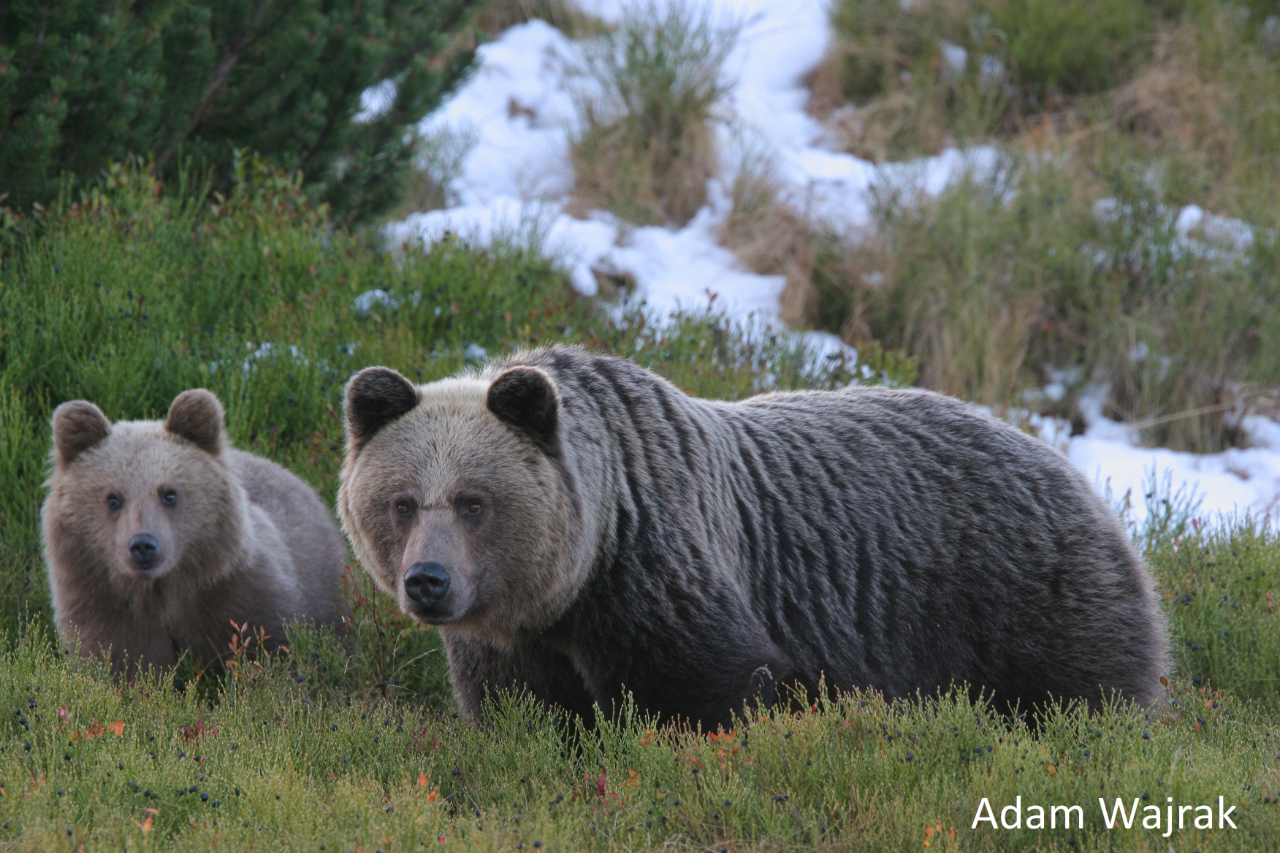Plants in brown bear diet
International team of researchers, led by Alberto García-Rodríguez from the PAS Institute of Nature Conservation, collected data about the number of different plant species eaten by brown bears. Scientists analyzed diet of 96 bear populations from Europe, Asia and North America. Their findings have been recently published in Scientific Reports.
Female bear with her cub grazing in a blackberry (Vaccinium myrtillus) meadow in the Polish Tatra Mountains (photo: Adam Wajrak)
Brown bears (Ursus arctos), although classified as carnivores, are in fact the most omnivorous animals in the world, eating plants, berries, roots, mushrooms, insects, fish and even small mammals. But only few know, that sugar-rich foods such as fruits represent a quarter of brown bears’ annual diet. As a hibernator, these animals have to build up fat – their energy reserves – to survive the winter.
Brown bears as sweet tooth gardeners
Bears consume huge amounts of fruits from more than hundred different species. That’s why researchers decided to investigate how this plant-based diet is beneficial not only for bears but also for the plants that are eaten. As scientists noted only some of fruits eaten by bears are fully digested, while the rest are excreted undamaged. Due to the movements of bears, undamaged fruit seeds have a chance to travel long distances and sprout in new places.
To check this researchers performed germination experiment. They collected 11 fruit species most commonly eaten by bears in central Europe and fed captive bears with these fruits. Then from bear scats they extracted the seeds and sowed them. It turned out that seeds recovered from bear droppings germinate better than seeds embedded within the fleshy pulp. “We already knew that brown bears like fruits but now we demonstrate that for the fruits it is very beneficial to be eaten by a bear too. In fact, for a seed it is much better to be eaten by bears than to remain in the plant”, says Alberto García-Rodríguez, leading author of the study. Nuria Selva, supervisor of the study, highlights: “Brown bears seem to swallow the fruits without chewing them a lot. This explains why we found a large proportion of undamaged seeds in the bear scats”.
Northern fruit-eaters
Is there anything else that makes bears good gardeners? Yes, indeed. Scientists observed that bear behavior, such as digging, can create favorable conditions for seeds to germinate. This is of particular importance in temperate and northern regions, where other large fruit-eaters (frugivores) are scarce or even absent. It seems that brown bears are likely to play an significant role in plant population dynamics as they are responsible for dispersing seeds over great distances.
“During the last centuries, humans have extirpated most of the large frugivores from many areas. Some species, such as elephants and rhinos, still remain in the tropics, and have a key role in the dispersal of seeds and the survival of the plants. The absence of other large frugivores in non-tropical regions implies that, in these areas, bears are the only animals able to move seeds over long distances from the places where they feed. These long-distance movements are essential for plants because they guarantee the exchange of genetic information among plant populations and facilitate the colonization of new areas” García-Rodríguez concludes.
The study on brown bears diet was led by researchers from the Institute of Nature Conservation (Polish Academy of Sciences) in collaboration with the Senckenberg Biodiversity and Research Centre and the University of Marburg in Germany, the Institute of Natural Products and Agrobiology of the Spanish Research Council in Spain and the Workshop for All Beings Association in Poland. The research took part within the framework of the BearConnect project.
The article “The role of the brown bear Ursus arctos as a legitimate megafaunal seed disperser” was featured in Scientific Reports, an open access journal from the publishers of Nature.
Source of information: PAS Institute of Nature Conservation

